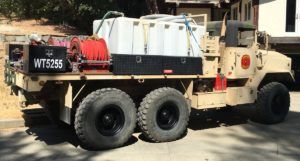Wildfire season is quickly approaching in California, and marijuana farmers all over the immense state are trying to bolster their defenses against a perennial threat that wreaked record-setting havoc in 2020.
Conditions appear worse this year, and marijuana growers are making preparations as best they can.
Robert Steffano recently concluded maintenance checks on 30 fire extinguishers strategically located on his Humboldt County-based Villa Paradiso Farms, which produces and sells bulk flower to distributors.
The firefighting devices are on every rig and quad, down at the pumphouse, at the power station, the main compound and near the solar panel system.
“The key to survival out here is immediate suppression,” said Steffano, a longtime volunteer fireman and cannabis grower who knows the terrain better than most.
“If there’s smoke, you’re on it.”
Also among Steffano’s firefighting arsenal is The Wookie, a military 6×6 cargo truck he retrofitted with a 1,000-gallon water tank, 100-foot fire hose and industry-grade pump.
The truck stands ready for action at a moment’s notice.

Drought conditions renew concerns
The Sierra Nevada mountain range snowpack, which accounts for 30% of California’s fresh water in a typical year, was at 59% of its yearly average on April 1, considered the end of the rain and snow season.
It’s the second significant shortage in two years, prompting the U.S. Drought Monitor, as of press time, to categorize most of Northern California’s fertile cannabis growing region as being under severe or extreme drought.
“Everything is accelerated because of the dryness,” Steffano said. “There’s no rain.”
The conditions are just as dire on the Central Coast, where Lowell Farms operates a 225,000-square-foot greenhouse in Monterey County.
Though the greenhouse is miles from woodlands, Lowell is implementing contingencies to mitigate wildfire air-quality and heat issues, which can severely damage crops.
“We are automating our greenhouses with emergency sequences that can respond in a moment’s notice to these adverse conditions,” Lowell Board Chair George Allen said.
Fighting Fires in the Emerald Triangle
Steffano grows in a tightly knit community in the heart of California’s famed Emerald Triangle, near where Humboldt borders Mendocino and Trinity counties.
In 1983, concerned residents there formed the Palo Verde Volunteer Fire Department. Steffano joined the ragtag crew five years later, when a small Jeep and water pump served as its firetruck.
“It was really down-home,” recalled Steffano, who served as emergency medical technician for 15 years and later as fire chief.
Much has changed since those early years. The Palo Verde Fire Department now has a small fleet of reliable trucks and equipment.
And roughly 30 volunteers – including Steffano – have gone through basic wildland training, an essential wilderness curriculum for properly arranging hose lays, scratching scrum, creating firebreaks and deploying shelters, among other firefighting and prevention measures.
The skill sets were instrumental last fall, when Steffano and other volunteers worked several sleepless nights fighting the August Complex fire while helping evacuate residents and tending to their livestock.
“Everyone looks out after everyone else,” Steffano said. “Wildfires have always been a present danger for us out here.”
The record blaze burned for nearly three months, killed one firefighter, destroyed more than 930 structures and torched more than 1 million acres – roughly 1% of California’s landmass.
Jeff Ghidella is working on installing portable water sources around his farm, Little Hill Cultivators, in southern Trinity County in Northern California.
Ghidella’s barn, a few sheds and a couple of other build-outs were among the structures lost after a windstorm ripped through the area, nuking a hillside just west of his property.
The fire, originally sparked by lightning nearly 30 miles away, melted waterlines up the hill and shredded his greenhouses.
He tried to harvest one greenhouse but to no avail.
Ghidella estimated his losses at $400,000 – including his entire fall crop – and the damages were not covered under his home insurance policy.
“I was able to save my house,” he said. “My two neighbors lost everything.”
Other regional growers, such as Fumé, which has been cultivating small cannabis gardens for three years in nearby Lake County, fared better.
“We made sure to plant the gardens with plenty of fire protection around them,” said Eric Sklar, CEO of Fumé.
”We immediately tested the plants after the fires and at the end of the season and found no trace of anything harmful.”
Steffano’s off-the-grid farm, located on a 60-acre property with solar and hydroelectric power as well as a rainwater-catchment system, was spared as well. Hundreds of pounds of ash were blasted off saved crops with four big wind blowers, he said.
New challenges and solutions
Assessing annual economic losses and damages in the cannabis industry caused by wildfires is a difficult task in California.
Data is scant, and losses tend to be anecdotal.
California’s Bureau of Cannabis Control didn’t respond to MJBizDaily inquiries regarding wildfire impacts to marijuana businesses.
The California Growers Association (CGA), one of the state’s most vocal and influential advocates when it was operational, tried to inventory fire damage in 2016 and recorded losses eclipsing $100 million.
“That’s what we were able to document,” said Hezekiah Allen, a former executive director of the CGA who now advises cannabis companies.
“We gave up the next couple of years. It was just too hard.”
As wildfire season gets longer and more dangerous with each passing year, remote communities in California are become more self-sufficient.
Residents in the Palo Verde area are buying old pickup trucks and outfitting them with 200-gallon tanks and a Honda pump.
One homesteader has amassed a small private battalion, while others prep for Community Emergency Response Team (CERT) training.
Steffano’s farm is practicing fuel reduction, pulling brush and cutting down lower tree branches.
Ghidella is clearing brush on a few acres of developed land, carving firebreak lines down to mineral soil around important infrastructure, improving sprinkler systems, upgrading wells and storing extra gasoline and fuel on the 120-acre property in case another disaster strikes.
Ghidella, who’s been cultivating cannabis for 20 years, said he can’t afford another setback.
“I really need this crop to come through and work out,” he said, “or I’ll be in rough shape.”
Chris Casacchia can be reached at ccasacchia@hotmail.com.




